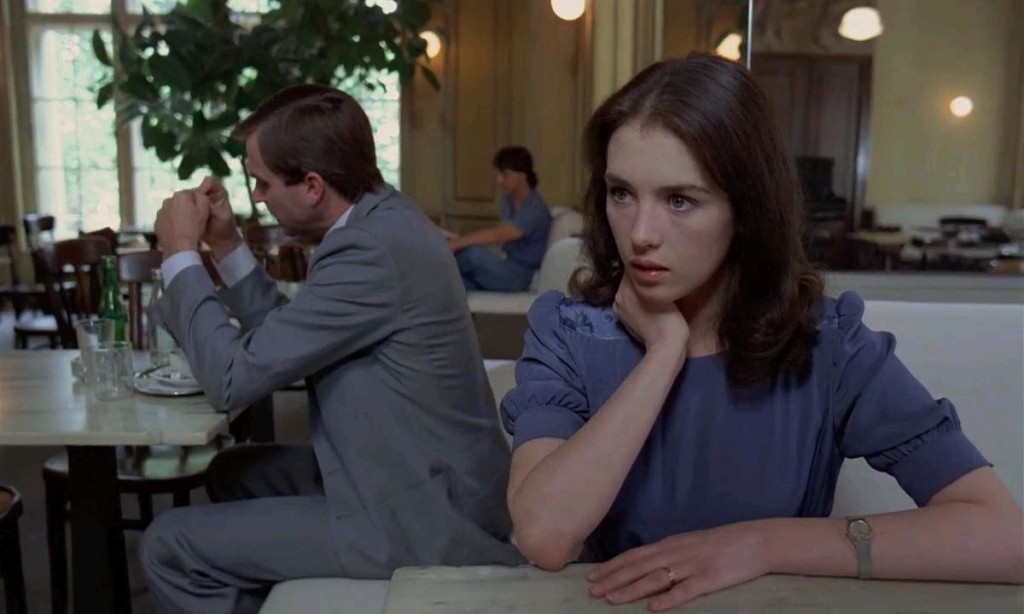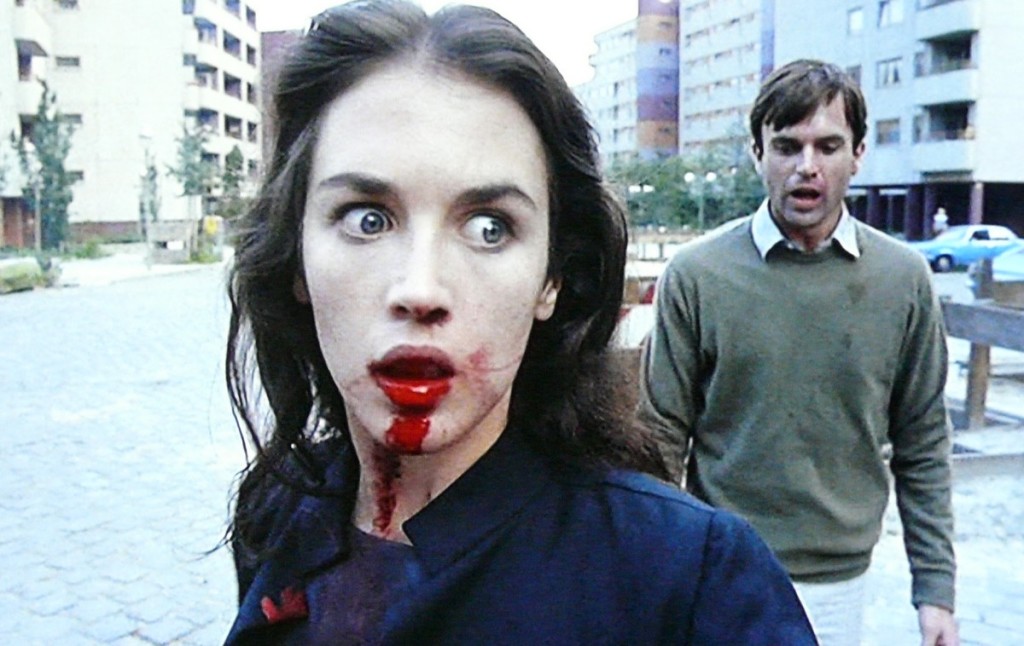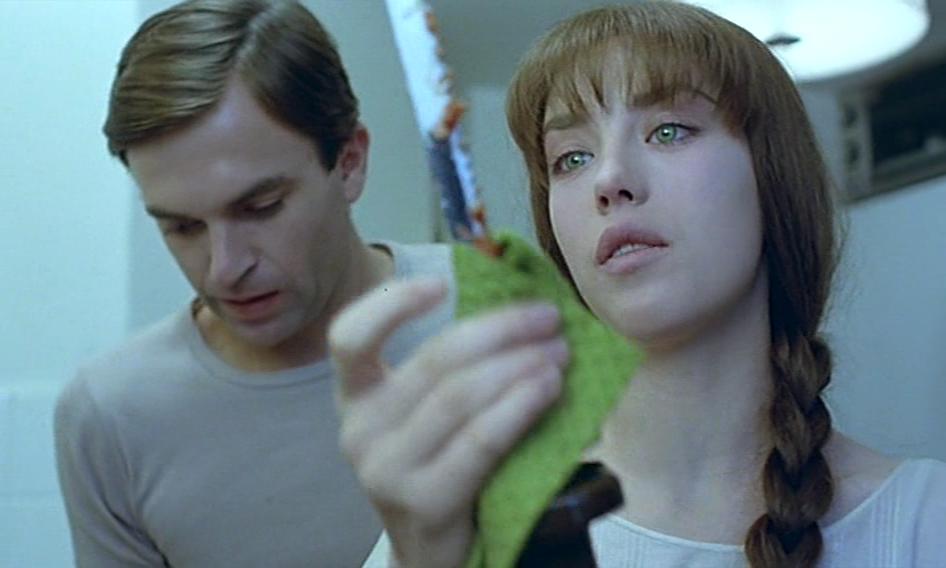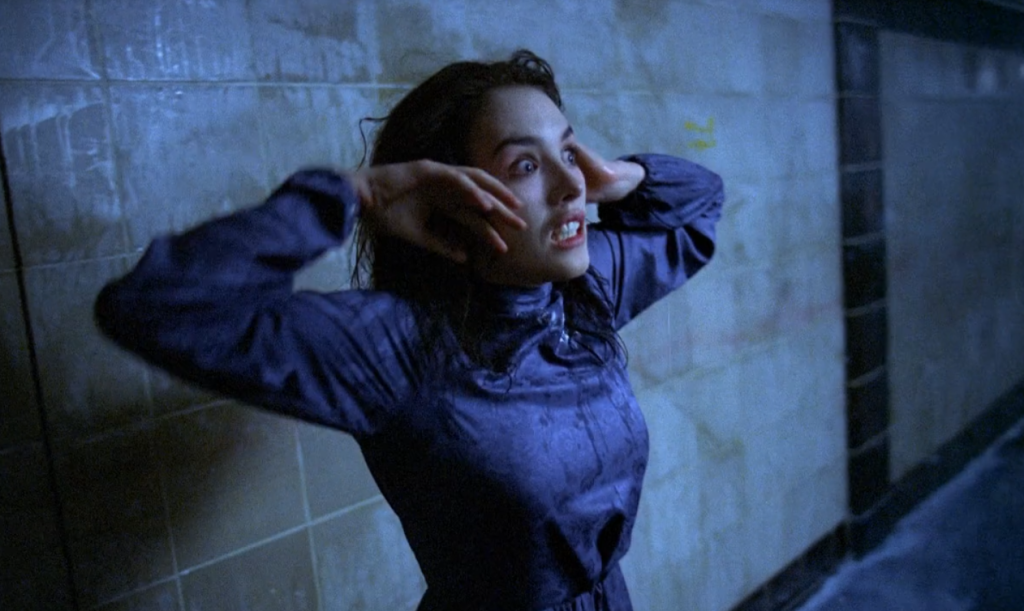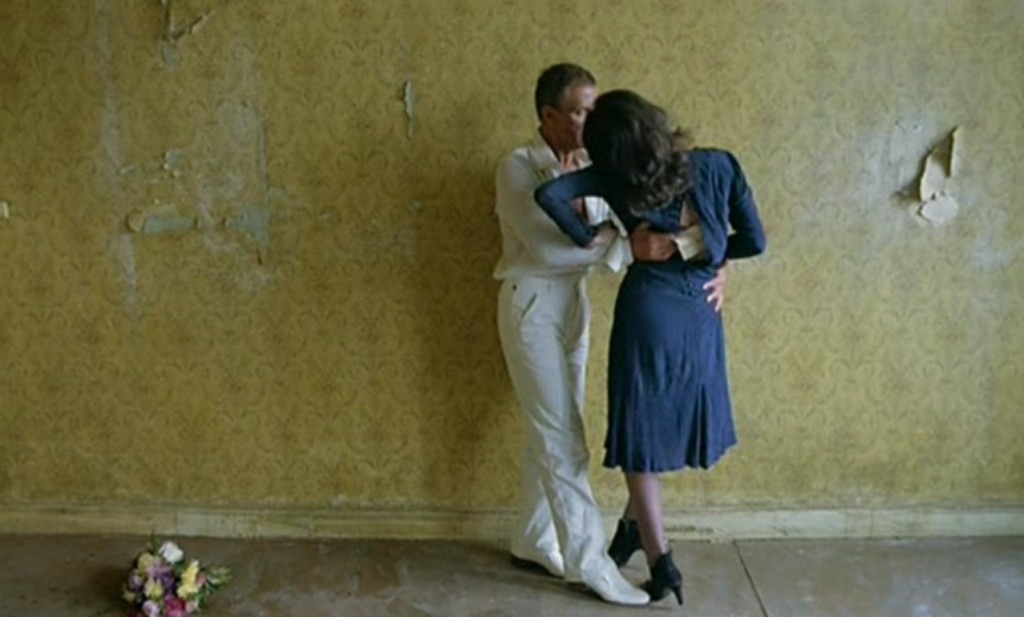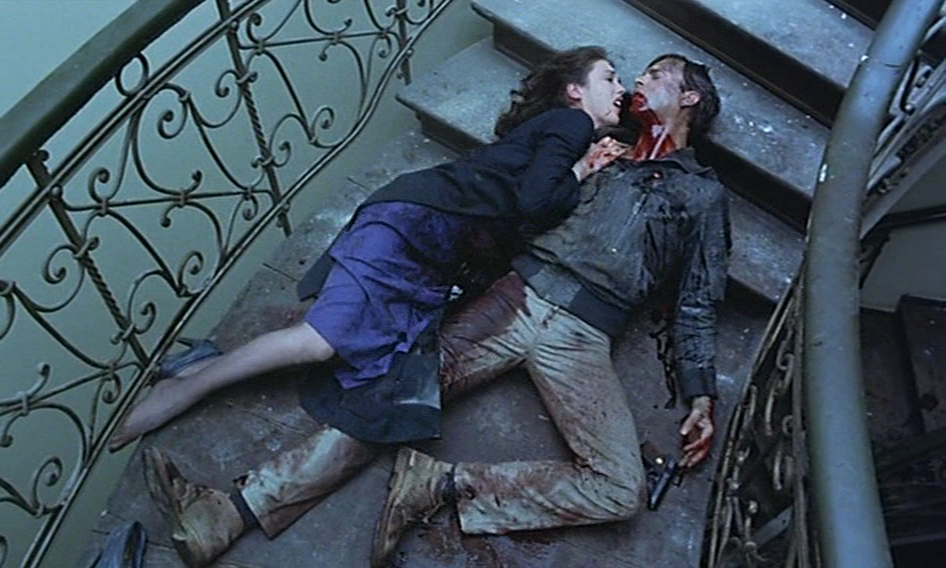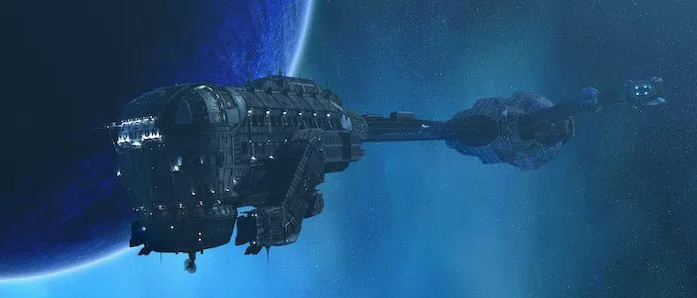
This January, in support of the Toronto Rape Crisis Centre / Multicultural Women Against Rape, friends and family have raised over $1,500 (which, when matched by my employer, totals $3,000). As a result, I now have to watch and write about thirty-one horror movies: one each night. Any donors who contributed over $30 were given the option to choose one of the horror movies I must subject myself to. After each viewing, I will write some things about said movies on this website. Be forewarned that all such write-ups will contain spoilers, and many of them will refer to unpleasant and potentially triggering situations. Today’s film, as selected by David Demchuk, author of the Giller-longlisted book, The Bone Mother, is Event Horizon (1997), directed by Paul W.S. Anderson (Mortal Kombat, Resident Evil). On the two-year anniversary of our first meeting – when we watched Lake Mungo for a previous horror movie marathon of mine – David came over and we rented Event Horizon from YouTube.
What happens:
Trigger warnings: Suicide, eye trauma.
Event Horizon begins – as all iconic films do – with a techno score over the opening credits. (This is a Paul W.S. Anderson film, after all.) As the throbbing bass and drum subside, opening titles outline some recent space travel history, including how, in 2015, human beings first colonized the moon. (Did you already forget about that?) Of relevance to our story, in 2040, a deep space vessel called the Event Horizon went missing somewhere outside of Neptune. And now, in 2047, the crew of USAC rescue vessel the Lewis and Clark sets out to find them.
The film opens with a nightmare: in the corridor of a large spaceship, we see a man who has been sliced open with blades, rotating in zero gravity. The dreamer, Dr. William Weir (Sam Neill), awakes with a start in bed. He touches the photos of his wife, Claire (Holley Chant), on his wall longingly and says, “I miss you.”
Dr. Weir meets with his crew, an Aliens-derivative bunch of toughs who say things like “5 by 5”: Captain Miller (Laurence Fishburne) introduces him to their communications officer Lt. Starck (Joely Richardson), their med tech, Peters (Kathleen Quinlan), their pilot Smith (Sean Pertwee), the rescue tech,Cooper (Richard T. Jones), the young guy (whose role I didn’t catch), Justin (Jack Nosweworthy), and D.J. (Jason Isaacs), who works in trauma. They enter the “graft tanks,” massive capsules filled with translucent green goo that puts their bodies in stasis so they can survive the long distances of space travel. Dr. Weir escapes the graft tank before everyone else and staggers around, showing off his dad bod. He hears whispers through the ship and finally finds his wife, Claire, seated naked at the helm. As he turns the chair around, a hand grabs him and his wife’s eyes pop open to reveal they’re blood-red … and it’s another nightmare!
Eventually, Weir actually evacuates the pods with the rest of the crew. Once they’ve dressed and eaten and Cooper has sexually harassed Starck, they ask the doctor why they’re on the far reaches of the solar system. After all, most of them were pulled out of leave for this mission, and some of them have kids at home – like Peters. Dr. Weir explains that the USAC received a phantom distress signal from the long-thought-missing Event Horizon, and they are going to retrieve the ship and its crew. The official story was that the ship malfunctioned and exploded. But the reality is that the ship is able to travel great distances in a short time by folding space-time when it generates a singularity. Weir uses a centrefold pin-up to explain how the shortest distance between two points can sometimes be a zero. And the person who invented this time-space-bending vessel: none other than Dr. Weir himself.
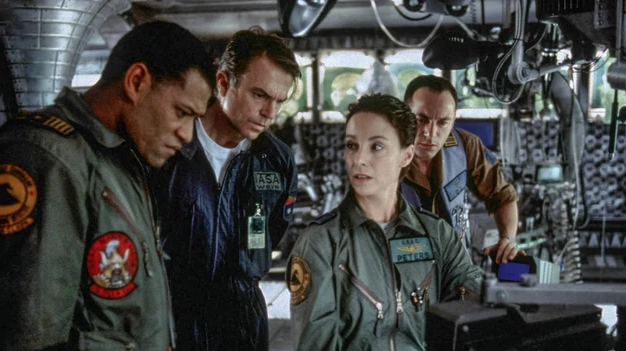
The ship never exploded: it just went off their radars for seven years … and now it’s back. Weir plays the last radio transmission from the Event Horizon and it’s a discouraging audio clip: lots of screaming and agony and even some Latin. DJ, who learned Latin when he took his Hippocratic oath (I guess), translates it as “save me.” The crew of the Lewis and Clark, a ship with an aesthetic more Alien than Star Trek, makes a choppy entry into Neptune’s orbit, where the Event Horizon should be located. They barely see the massive interstellar ship until they’re right beside. Their readings indicate the hull is intact but the interior lacks gravity and is locked in a deep freeze. The rescue crew will have to board the ship and investigate room-by-room. Dr. Weir positively licks his lips at the chance, and is outraged when he’s told he needs to stay on the Lewis and Clark until they can determine if the Event Horizon is safe.
An initial squad of the Captain, Justin, and Peters, tethered to the rescue ship by an approximation of an umbilical cord, enter through the auspicious airlock number 13. They first encounter a long corridor that separates the cockpit from the other areas of the ship, and see explosives lining the walls. Dr. Weir explains: in an emergency, these can be detonated to separate the cockpit from the rest of the ship. The trio walk through long ice-frosted halls floating with debris, and find nothing: “This place is a tomb.” Justin investigates Engineering by travelling through a hallway that looks like a rock tumbler (or meat grinder). Peters heads to the bridge, where blood stains the controls and flesh and gore seems to be hanging from the walls like bunting. She finds the ship’s log – on CD-ROM, of course – and while she’s trying to get it to play is startled by a frozen corpse covered with lacerations and missing its eyes. This does not look like the standard effects of exposure to deep space.
Back in Engineering, Justin finds the engine core. Coolant has leaked out and is floating around in blobs. The core itself – three massive interlocking rings which look like they were designed by Clive Barker – is radiating weird signals. Suddenly it opens up with a white light and sucks Justin into a portal. His video signal goes dark. Justin’s tether is yanked into the portal, as well, dragging the Lewis and Clark into the Event Horizon. The collision causes explosions and a series of fires in the rescue ship, where Dr. Weir and the others are. Cooper, determined to rescue Justin, follows the cord along to the very core. Just as he approaches, Justin floats out, apparently in a trance.
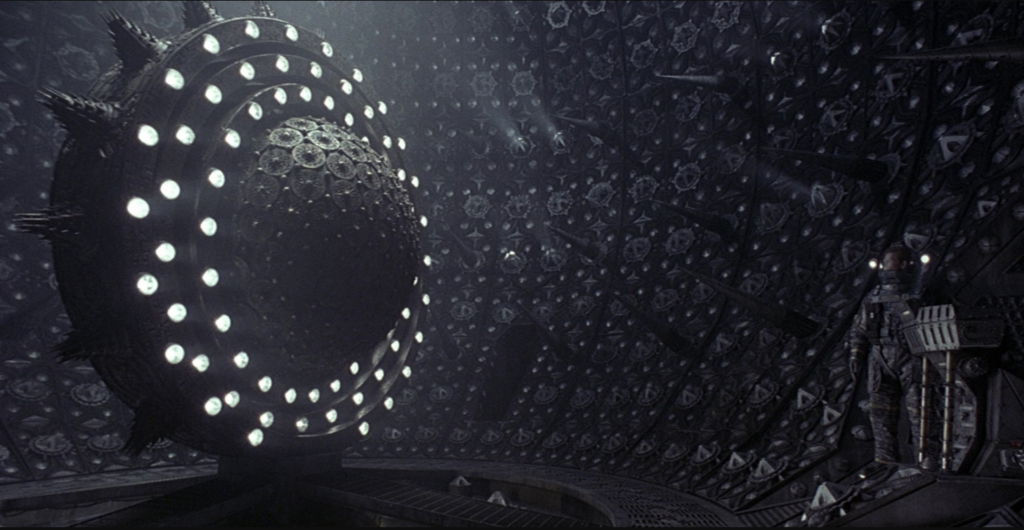
During the collision, the hull of the rescue ship was breached. Captain Miller decides they must they must re-establish living conditions the Event Horizon, then transfer themselves to that ship while they repair the Lewis and Clark. They re-establish gravity in the Event Horizon, causing the frozen corpse to drop to the ground and shatter into blood and gore. Dr. Weir gets the other systems online, but communications still seem to be down. No one knows what’s happened to them. Furthermore, the Event Horizon is filling up with carbon dioxide and in about twenty hours, the air won’t be breathable. Smith, the pilot, assesses the damage to the Lewis and Clark and figures he and Copper can complete the repairs in time.
Justin is physically fine, but has been catatonic since entering the core. When Weir is told by Cooper that the core was open, he dismisses it as fantasy; that what he saw must be “an optical effect caused by gravitational distortion.” (Also, no one seems too unsettled by the fact that human flesh is hanging like curtains in the backdrop.) When Captain Miller presses Weir on how the engine core works, Weir explains the three rings of the core, when aligned, create a black hole that bends space-time. Miller orders that the core room be sealed, which frustrates Dr. Weir. His obsession with the core grows.
Peters tends to the unresponsive Justin in the medical bay, watching videos of her family at home. Then she hears an agonized sigh. She picks up what can only be described as a surgical cleaver and tries to find the source of the sound. Zeroing in on a glowing oxygen tent, she rips it open to find her young son (!), who looks up at her and says, “Mommy.” Peters looks down and sees that his legs have been rotted through. She panics until DJ, the trauma doctor, grabs her shoulder. Her son vanishes. It must have been a hallucination!
Peters (who I guess has to do everything on this ship) manages to get the CD-ROM log working. What starts as a normal video message – one establishing the captain’s penchant for Latin phrases – turns staticky, with brief glimpses of disturbing events that can’t be fully understood. Peters will try to get some filters on the video to produce a better image. The core, meanwhile, is acting wonky, and Weir volunteers to investigate. Just as the core begins to act up, Justin, on a bed in the sick bay, seizures and grabs DJ by the shoulders.
Weir enters the core’s guts, crawling through a tunnel of neon-green motherboards in a cyberpunk tribute to 2001. Captain Miller stands watch outside. While repairing the damaged board, Weir hears a voice calling “Billy.” When he follows the voices, he finds his wife with the blood-red eyes, who forcefully suggests, “Be with me FOREVER.” Miller, outside, sees a flaming corpse emerge from the puddle of engine coolant.
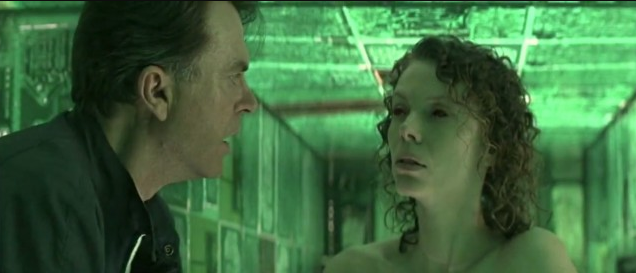
Back in the cockpit, they discuss the weird things they all have been seeing. Miller is convinced these are not just hallucinations: they’re so much more vivid. They’re somehow real. Smith blames Weir for messing around with the laws of physics by creating black holes and the two attack one another physically until DJ restrains the doctor by holding a scalpel to his throat (which doesn’t seem like the most level-headed way to break up a fight). After that, Lt. Starck voices her theory: that the ship is reacting to them … that it’s alive.
Captain Miller, Cooper, and Smith don space suits and begin to repair the Lewis and Clark from the outside. Everything seems to be going well until Justin goes missing form the medical bay. Then the overhead lights in the room begin to explode. Peters rushes to the others in the cockpit, closing the giant metal door behind her. As soon as she does, it begins to collapse inward. Something is trying to smash its way in. Dr. Weir, eerily calm, insists they “open the door.” The banging continues. When the crew refuses, Weir goes to open it himself, and only Lt. Starck nearly breaking his elbow with some Krav Maga can restrain him.
The loud entry attempts subside, but that’s when Justin reappears: he’s decided to go into one of the ship’s airlocks without a spacesuit. (This is generally a bad idea in space movies.) The crew informs Captain Miller, who ditches the repairs and races along the outside of the ship to get to that airlock. Peters, meanwhile, attempts to reason with Justin, who seems about to commit a very gruesome form of suicide. But Justin is hard to convince and recounts his experience in the black hole. “It shows you things,” he says. “Horrible things. From the dark inside me.” He begins the process to open the airlock.
A moment later, though, Justin regains lucidity and starts to panic about the airlock opening. But none of the crew can stop the process – it’s up to Captain Miller to get to him in time. As Justin is exposed to the vacuum of space, his veins start to bulge and he begins to bleed profusely from every orifice. Justin begins to spasm but – just in the nick of time – Captain Miller dives in and saves him. DJ stabilizes the young crewmate, who should eventually recover.

With only four hours left of air, Captain Miller demands to know what’s going on: Weir must know something and Miller is tired of his evasive answers. While they really should be using the buddy system at this point, the crew members continue to work separately in the spooky old ship and are plagued with violent images in their heads. Miller confesses to DJ about his hallucination: in his younger days, he was embroiled in a fire a zero gravity. He abandoned one of his crew members, who burned alive. He’s being haunted by his ghost. DJ has been busy re-translating that audio signal and has re-evaluated its meaning. He thinks what the voice was actually saying was, “Save yourself … from Hell.”
The good news is that repairs on the Lewis and Clark are going well: Cooper anticipates the job should be done in under a half-hour. And not a moment too soon, too, as Peters has finally fixed up that last video log and it’s not a good scene. The previously scrambled footage is jam-packed with people eating, defiling, and murdering one other (of which we see unpleasant glimpses), and ends with a shot of the captain holding out his own eyeballs in his palms, a la Saint Lucy. Miller decides they’re abandoning the Event Horizon asap, and destroying it as soon as they get in range. Dr. Weir, obviously, protests, but Miller has the right idea: “Fuck this ship!”
But fucking this ship won’t prove easy. The core, with a mind of its own, begins to drain power from other parts of the ship. Weir, for his part, descends further into obsession and begins to mind-meld with his ship: “I am home,” he says. While the crew is preparing to leave, Peters begins to see visions of her son running around. In shades of Don’t Look Now, she follows the ghostly child, which causes her to plummet down a hatch and fall to her bloody, painful demise.

Weir finds her dead body and it triggers a flashback from his past. He sees his wife, Claire, preparing for a bath and tries to prevent what he knows will happen. “I let my work come between us,” he laments. Then Claire slashes her wrists, and the scene concludes with a grim shot of her naked body in a bath full of blood. (It’s pretty rough.) The dream vision of Claire tells Weir to join her.
Smith contacts Miller to tell him he’s seen Weir messing about on their escape ship, the Lewis and Clark, which is troubling, as the Captain has noticed one of the explosives missing from the Event Horizon’s corridor. Smith finds the hidden explosive (which improbably uses a flip clock) in the Lewis and Clark moments too late. It explodes, killing Smith and sending Cooper (who was working on the hull) spinning into space. Luckily, through some quick thinking, Cooper is able to use the jets on his space suit to bring him back to the Horizon.
Over their radios, Miller gives DJ permission to take out Dr. Weir. He has become too much of a danger. But as soon as the order is given, Weir grabs the trauma doctor. Weir has gouged out his own eyes, leaving only bloody sockets. The doctor has somehow become very strong (unless he was always secretly a powerhouse) and quickly subdues DJ. He then lays him on a medical table and begins to perform a vivisection on him while he’s still alive.
Captain Miller enters the medical bay and finds the gory horror show of DJ’s remains. He retrieves some sort of harpoon gun and searches for Weir. Instead he finds Starck, unconscious on the cockpit floor. Using good-old smelling salts, he wakes her, and they both realize Weir is still present, seated in the captain’s chair. With his eyeless, gory face – “Where we’re going, we don’t need eyes to see,” he says, paraphrasing Doc Brown from Back to the Future – he outlines that the core opened up a dimension of pure chaos, pure evil. And he has set course for the Event Horizon to return there. Starck attacks Weir, but Weir knocks her silly. (The eyes were holding him back.) There’s then a tense standoff of harpoon guns between Weir and Miller.
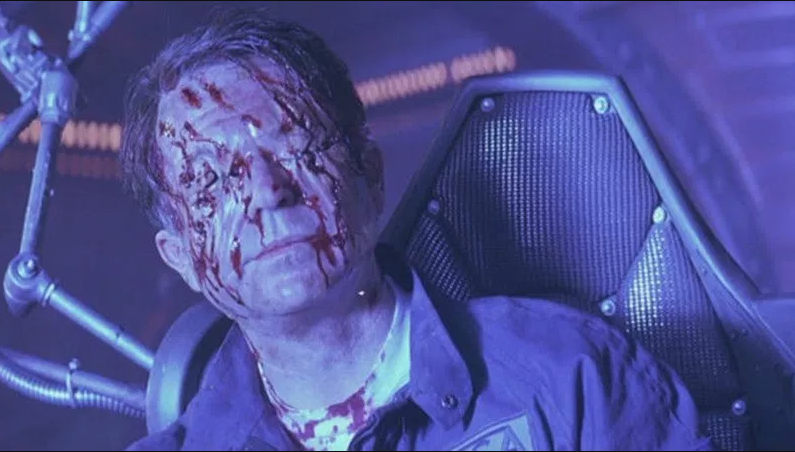
Chaos erupts when Cooper, zipping back to the ship, collides with the cockpit window. Weir fires at the window, which opens a hole in the ship. People and things begin to get sucked into the vacuum of space. Miller is able to hold onto a tether, but Weir is sucked out to his death (we assume). Miller is able to push himself and Starck – he’s not leaving anyone behind this time – within an inner room and hit the airlock. Cooper soon joins them safely inside.
But it’s not over. The ship is still charting course for the nightmare hell dimension. Miller decides he must activate the explosives in the corridor – manually, of course – to separate the cockpit from the core. While he leaves to do that, Cooper and Starck watch in horror as the cockpit becomes the elevator from The Shining, overflowing with blood. Miller arms the explosives, but the fiery friend from his hallucinations returns. The fire feels so real, he is forced back into the core to flee.
Once in the core, the fiery vision morphs into its real form: Dr. Weir, who’s changed a bit since we last saw him. He has his eyes again, but he’s completely naked and covered in large diagonal cuts, like a human jigsaw puzzle. “The ship brought me back,” he (sort of) explains. Weir grabs Miller to show him a vision of his future: he and his crew, cut up, covered with maggots, impaled and tortured. Miller and Weir fight hand-to-hand. When Miller realizes he’s no match for the newly powerful doctor, he bargains for the life of the rest of the crew: “Take me. Leave them alone.” But Weir doesn’t like that trade. Miller manages to find the explosives detonator he dropped earlier and blows the entire core – killing both him and Weir.
The crew in the cockpit have a rough ride, but manage to break free from the exploding Event Horizon and drift into space. They watch as a black hole swallows up the exploding remainder of the ship. They’ve survived.
Seventy-two days later, a rescue crew boards the remaining portion of the Event Horizon They note three survivors in the graft tanks: Justin (very injured), Cooper, and Starck. Starck is the first to be revived, but when the rescuer removes his helmet – it’s Dr. Weir! All cut up and gross! But it’s just a fake-out., a nightmare of Starck’s. Moments later, the three survivors experience an actual rescue. Cue techno music for the end credits.
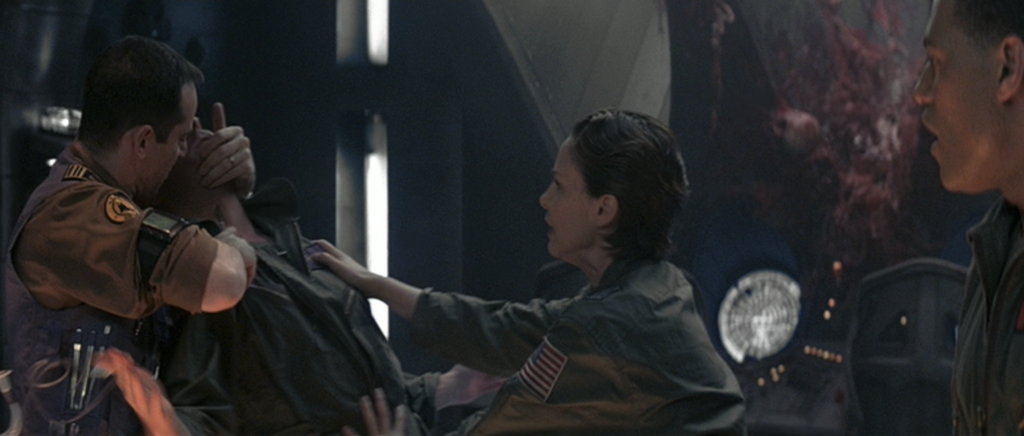
Takeaway points:
- Among other things, Event Horizon is notable for the incredible number of influences it homages (or steals from). The crew is very much lifted from Aliens. The subplot of Dr. Weir and his wife committing suicide is straight out of Solaris. Somehow, Anderson manages to jam in overt references to non-space films like The Shining, Hellraiser. and Don’t Look Now in there, too. But is it a loving tribute, or a lazy shorthand intended to produce maximum scares?
- Interestingly, David noted that while Event Horizon wears its many (better) influences on its sleeve, the film itself has become a big influence on a lot of video games: Dead Space, Prey, etc. Perhaps because it collects all these tropes in a nice little package, or perhaps because space horror is a genre seen more in gaming than on screen, Event Horizon has become a sort of cultural touchstone in that world.
- Odd thematic interpretation time: is Event Horizon a workaholic’s nightmare? Dr. Weir is the creator of the ship. He blames his commitment to his work for his wife’s suicide. But his work is his home. And his obsession with this home (the ship) leads him to run willingly headlong into a hell dimension. Whereas Miller and the rest of the crew – Peters, especially – are depicted as people who would really prefer to have some downtime. They’re pulled out of their vacations! The crew members are all very good at their jobs, but also recognize the importance of a work-life balance. Yet they are sucked into this work-related hellscape by one man’s workaholism. Event Horizon is a cautionary tale about leaving some things at the office.
- My fellow viewer, David Demchuk, was particularly interested in the way Event Horizon views eyes and seeing. In both the case of the original crew and Dr. Weir, the hell dimension impels them to gouge out their own eyes. That eyes are not needed to “see” this other world. Likewise, Justin in haunted by what the other dimension made him see – inside himself, no less. The ghost of Claire is always seen with bloody eyes. To truly embrace the “other side,” one must take way one’s vision. (I have no idea what this all means … but something’s there.)
- In retrospect, it seems like an obvious blunder to name your ship Event Horizon, given it’s the point at which there is no escaping a black hole. That would be like naming a water vessel Iceberg Magnet.
- Just Lt. Starck’s luck: she manages to survive the entire movie and one of the two other survivors is the guy who spent the opening of the movie sexually harassing her.
Truly terrifying or truly terrible?: Event Horizon is a fine film. I’m no Paul W.S. Anderson hater – I will viciously defend Mortal Kombat as the greatest video game adaptation ever made – but I didn’t think this movie was overly scary. If it weren’t so gruesome, this would be like one of those dependable movies that used to run weekends on TBS. You’ll have a good time, but I found it too derivative of its sources to be truly scary.
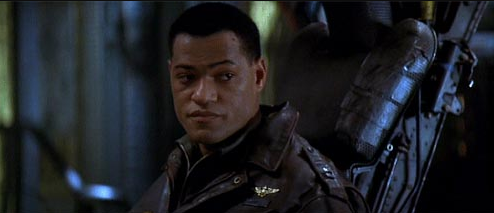
Best outfit: The fashion is pretty samesy. Maybe Captain Miller’s bomber jacket?
Best line: “FUCK. THIS. SHIP.” – Captain Miller, in what should have been the film’s tagline.
Best kill: For a gory movie, not a lot of principal characters die on-screen. Most of the horrific scenes are just nightmare visions of torture and death. DJ’s very elective surgery probably wins for most memorable.
Unexpected cameo: DJ is played by Jason Isaacs, who 90’s kids will know better as Lucius Malfoy from the Harry Potter films or Captain Lorca from the new Star Trek: Discover.
Unexpected lesson learned: CD-ROMs will come back into fashion in the 2040s, as will propulsive techno music.
Most suitable band name derived from the movie: Airlock 13.
Next up: Silver Bullet (1985).

